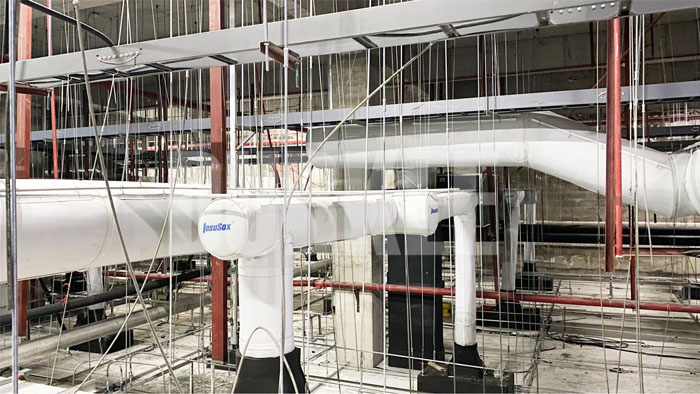 How Durkee Smart HVAC Innovations Take Center Stage at China Refrigeration 2025
How Durkee Smart HVAC Innovations Take Center Stage at China Refrigeration 2025
 Advantages and Prospects of Cloth Air Ducts
Advantages and Prospects of Cloth Air Ducts
 Fabric Duct: Innovator of Flexible Ventilation Systems
Fabric Duct: Innovator of Flexible Ventilation Systems
When discussing modern heating, ventilation, and air conditioning (HVAC) systems, one often overlooked component is the air ducting. Air ducting, also referred to simply as "ducting," is a vital part of HVAC systems. It serves as pathways that transport heated or cooled air throughout a facility, ensuring a balanced and comfortable indoor environment. Brands like Durkduct specialize in high-quality ducting solutions to meet various industrial, residential and commercial needs.

The primary purpose of duct sock is to deliver temperature-controlled air to different parts of a facility efficiently. This system plays a critical role in maintaining indoor air quality, temperature, and overall comfort. Below are some specific functions of ducting:
1. Temperature Regulation: The cloth air duct transports heated air from furnaces or cooled air from air conditioning units to various place, maintaining desired temperatures.
2. Air Quality: Properly sealed and insulated ducts ensure minimal leakage, preventing contaminants from entering the system and keeping indoor air clean.
3. Energy Efficiency: Efficient ducting systems can significantly lower energy consumption by reducing the amount of work required by HVAC units to maintain set temperatures.
Not all ducting systems are created equal; understanding the different types can help you make informed decisions tailored to your specific needs. Here are the three primary types of ducting:
-Description: Typically made from materials like galvanized steel or aluminum.
-Pros: Highly durable and long-lasting, relatively easy to clean, and less prone to mold growth.
-Cons: Installation can be labor-intensive and costly due to the need for precise measurements and cutting.
-Alternative : Fabric Air Duct System
Description: A lightweight, flexible, and customizable ducting solution made from high-performance fabric materials.
Advantages: Easier and faster installation, energy-efficient airflow distribution, resistant to condensation, and aesthetically pleasing. Ideal for environments where traditional rigid ducts are impractical or costly.
-Description: Made of a metal wire coil covered with a flexible, durable plastic.
-Pros: Easier and quicker to install, can navigate around obstacles and bends.
-Cons: More prone to tears, leaks, and blockages, which can reduce airflow efficiency over time.
-Alternative: Integrated Fabric Air Duct with Thermal Insulation
Description: Combines a fabric air duct layer with elastomeric thermal insulation material using patented global technologies.
Advantages: Superior thermal efficiency, reduced energy loss, and enhanced durability compared to traditional flexible ducts. Perfect for applications requiring both flexibility and insulation, such as HVAC systems in commercial or industrial settings.
-Description: Combines both rigid and flexible ducting characteristics, usually made from flexible aluminum.
-Pros: Offers a balance between durability and flexibility, easier to clean than flexible ducts.
-Cons: not as durable as rigid ducting, can be somewhat more expensive than flexible ducting options.
-Alternative: Composite Non-rigid Air Duct Systems
Description: Advanced systems that blend the structural benefits of flexible ducting with the lightweight, customizable properties of fabric ducts.
Advantages: Combines durability, flexibility, and energy efficiency, making it suitable for a wide range of applications, from industrial facilities to modern architectural designs.
Understanding how air ducting works can help architect, contractor, owners and business operators appreciate the complexity and importance of these systems. Whether you’re using traditional rigid, flexible, or semi-rigid ducting—or alternatives like Fabric Air Duct Systems or Composite non-rigid air duct system—the basic principles of airflow and temperature control remain the same. Here’s a simplified breakdown of their operation:
-Initial Stage: The HVAC system pulls air from the interior spaces through return ducts. The air passes through filters that remove dust, pollen, and other contaminants.
-Action: Once filtered, the air is directed to either the furnace for heating or the air conditioning unit for cooling.
-Process: Depending on the thermostat settings, the HVAC unit will either heat or cool the air to the desired temperature.
-Via Supply Ducts: The conditioned air is then directed through a network of supply ducts to different zones in the facilities.
-Flow Control: Dampers within the ductwork help regulate airflow to ensure even distribution and maintain balanced temperatures in every place.
Brands like Durkduct offer optimized ducting hvac solutions to ensure that each of these stages operates at maximum efficiency. Proper maintenance and occasional upgrades can further enhance performance and energy savings.
Air ducting is an indispensable component of any HVAC system, contributing to temperature control, air quality, and overall efficiency. By understanding its purpose, the types of ducting available, and how it operates, you can make better decisions for your HVAC needs. When seeking reliable and efficient ducting hvac solutions, brands like Durkduct offer high-quality products that cater to a variety of requirements, ensuring comfort and efficiency in any indoor setting.
From rigid and flexible to semi-rigid and alternative non-rigid air ducting, each type has its own set of advantages and drawbacks. Knowing these differences can help you select the most suitable option for your particular situation. And with proper air ducting—whether traditional or modern—your HVAC system can perform at its best, providing a comfortable and healthy indoor environment year-round.